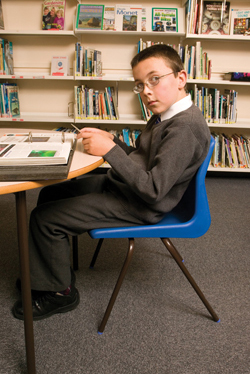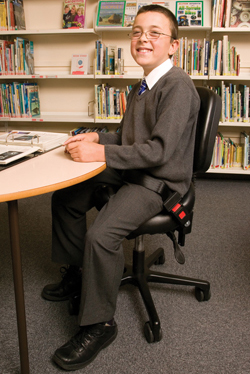9 years old
Cerebral Palsy


George was diagnosed with cerebral palsy when he was a year old. The condition mainly affects the right half of his body and both legs.
George has spasticity in both lower limbs, particularly in his hip abductors and hip flexors, medial hamstrings and calf muscles. This compromises George’s mobility and means that he walks with a flexed gait.
On conventional seating, George’s symptoms meant that he was unable to sit in a symmetrical posture and tended to lean to one side and slouch. This meant that George found certain school tasks difficult and would often use a raised board on his desk.
George required an easy, effective, comfortable and acceptable seating solution to achieve better hip and pelvic positioning, with his affected muscles in a more lengthened position than on conventional chairs.
The Bambach was recommended to George’s parents by his Physiotherapist.
George has now been using his Bambach for three years. He uses one at school where he is able to use the seat all day. He also uses a Bambach at home.
The Bambach prevents George from slouching when sitting and allows him to sit in a much improved symmetrical posture. By providing a stable and symmetrical pelvic and trunk position, the Bambach gives George a solid base which has facilitated his upper limb function making school tasks a great deal easier.
The sitting position on the Bambach places George’s hips in an abducted and externally rotated position and knees in a mid-range position. This places a passive stretch on the tight muscle groups which will help maintain muscle length, reducing the risk of medical/surgical interventions as he grows.